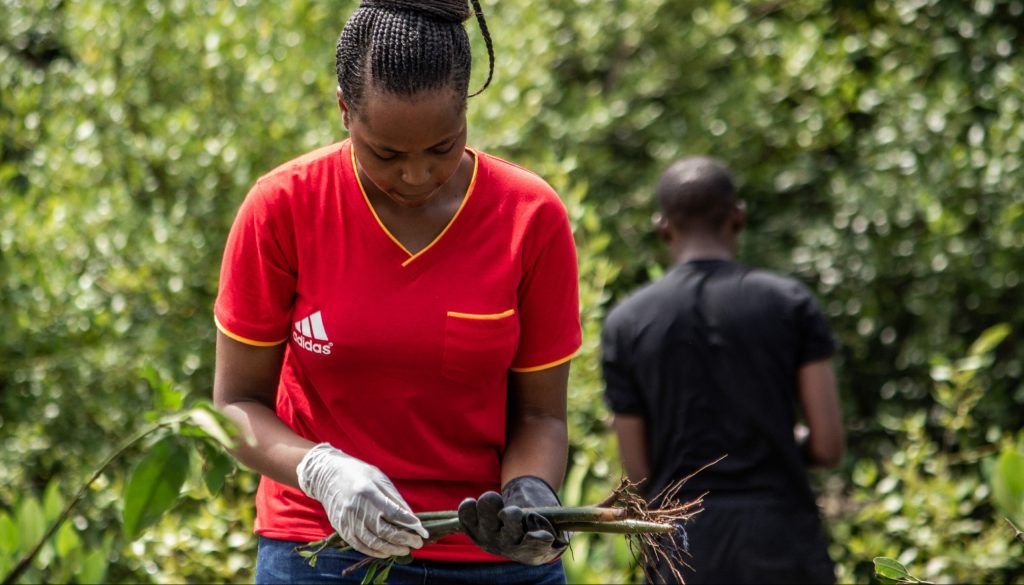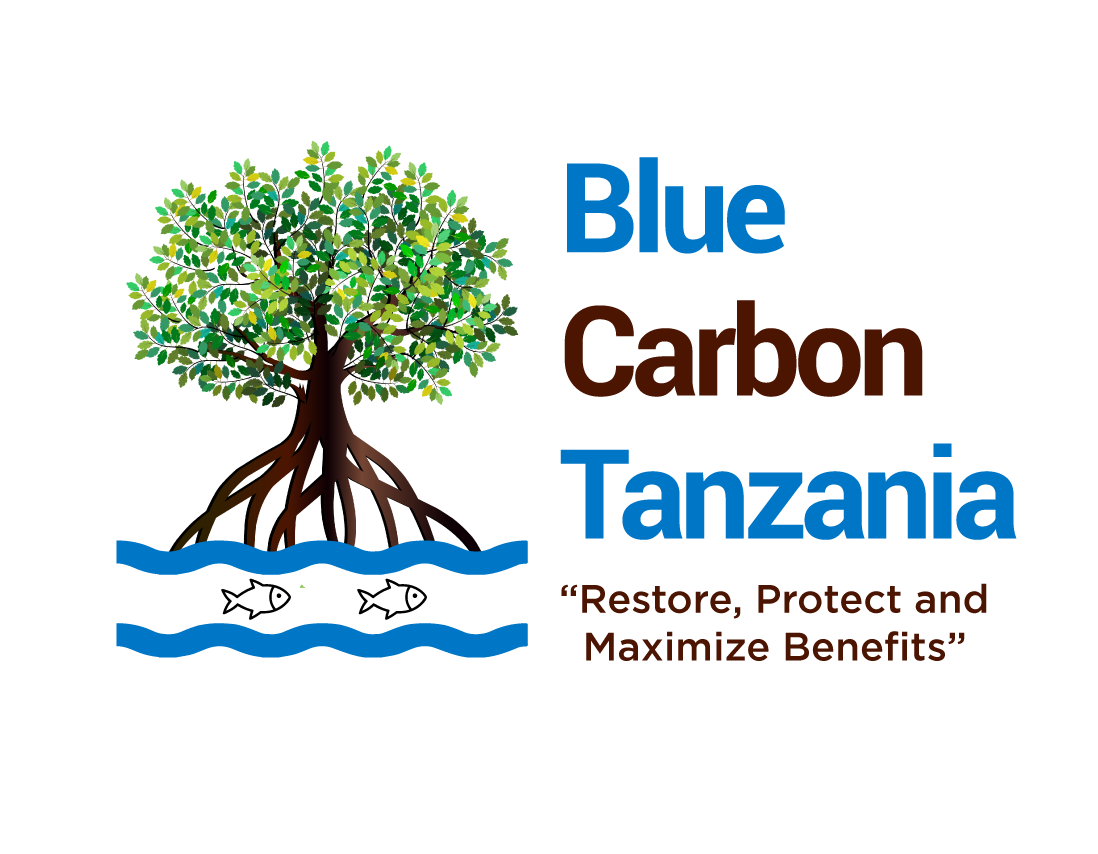Restoring a part of the planet’s lungs
There are many ways to fight climate change. Technology, Nature, Knowledge… But the one that is probably the most important one is passion. Our columnist Markus Sekulla learned that while talking to Debora Benjamen, the CEO and co-founder of Blue Carbon Tanzania, a start-up that sets out to restore mangroves in the country in eastern Africa and manages to solve a few problems simultaneously. Blue Carbon Tanzania takes part in the Carbon Removal ClimAccelerator programme of EIT Climate-KIC that is supported by Munich Re and ERGO.

Can you please give us the intro. Who are you? And what does Blue Carbon Tanzania do?
My name is Debora Benjamen, CEO and one of the co-founders of Blue Carbon Tanzania along with my colleague, Joseph. At Blue Carbon Tanzania, we work with coastal communities in Tanzania to restore mangroves.
And now, we are taking it to another level, not only restoring mangroves, but we also want to implement a blue carbon trading to support protection and restoration. We aim to establish a voluntary carbon market for the villages we are working with in Tanzania. For us, mangroves are not just trees; they have many advantages. They protect the coasts from erosion and storms, play a significant role in biodiversity, and contribute to fisheries. Mangroves can protect our planet and contribute more to climate mitigation, as they capture carbon emissions from the atmosphere ten times more effectively than other forests, like the rainforest. So, for us, focusing on mangroves is crucial due to these advantages.
If you weren’t a start-up founder, what profession would you pursue? What professional path would you choose?
I’m a marine scientist. I completed my bachelor in aquatic sciences and fisheries. Additionally, I did my Master’s degree in Marine and Lacustrine Science and Management, also known as Oceans & Lakes, a program at Vrije Universitat Brussels (VUB) in Belgium where we learned more about the ocean, coastal ecosystems, and mangroves became one of my favorites.
So, apart from this start-up, I am a researcher and currently a Humboldt climate protection fellow in Germany. I’m working on the Blue Carbon Project, which aligns with our start-up’s focus. So, besides being a start-up founder, I am engaged in research in the blue carbon area, specifically in mangroves.
How many people work for Blue Carbon Tanzania? And where are you based?
We are all based in Tanzania. I am the director, working with colleagues Joseph, Frida, and Joseph Sanga. We saw this opportunity and thought we could make a difference. Joseph, my colleague, is also a marine scientist. We both met in Belgium during our master’s studies. Additionally, we have Frida, a geologist who specializes in soil matters. Our work involves not just mangrove restoration but also scientific advancements to determine the appropriate species for specific sites. This presents challenges, but with Frida, who knows a lot about soil, we overcome them. We also have our finance manager, Joseph Sanga, who holds a Bachelor’s in accounting. So, we work with local communities, specifically three groups of women in three villages.

Debora Benjamen, Joseph Sanga and Frida Brayson
Can you describe in simple words what Blue Carbon Tanzania does?
In Tanzania, we plant mangroves. We do this to protect our coasts from erosion and storms. Sometimes, we invite school kids to join us in these activities. So, for a four-year-old, I’d say we plant trees to keep our shores safe from bad weather and help clean the air. Mangroves also provide homes for fish, so by planting more trees, we get more fish. In this way, we protect ourselves and help fight climate change.
“Tanzania has lost around 100,000 hectares of mangroves. If we can bring back these 100,000 hectares, we could remove around 100 million tonnes of CO2 from the atmosphere in the next 10 years.”
Debora Benjamen, CEO and co-founder of Blue Carbon Tanzania
That sounds like you’re solving a lot of problems simultaneously, which is great. And how did you become aware of these problems, like the shortage of mangroves? And what made you decide to do something about it?
Tanzania has lost around 100,000 hectares of mangroves. When mangroves die, they release a significant amount of carbon into the atmosphere. This loss of mangroves has contributed significantly to carbon emissions. We recognized that if this trend continues, it will become a significant problem. So, we decided to take action by restoring mangroves. Additionally, there’s a loss of coastal land.
You can see it as a part of our planet’s lungs, which is now missing. Restoring them means creating cleaner air for the next generation. If we can bring back these 100,000 hectares, we could remove around 100 million tonnes of CO2 from the atmosphere in the next 10 years. In the next 20 years, this could contribute to about one to 2% of the global target to remove 40 billion tons of carbon contributing to climate change. We plan to partner with different villages, training women, and achieving this goal over the next five years. We know it’s a lot of work, but with collaborations, we hope to make a significant impact.
What makes your start-up unique?
Firstly, we focus on nature-based solutions. Many organizations aim to remove CO2 with the help of technology from the atmosphere, but we stand out because we use nature to do so. We quantify these benefits, making our approach more valuable. Additionally, we are incorporating transparency into our process. We plan to use tools like IoT for real-time monitoring. This will allow our partners to see the actual progress and impact of their support.
Our success is rooted in our scientific-based restoration approach. In the past, we did mangrove restoration without a scientific basis, and the success was limited. Now, before planting mangroves, we conduct scientific analyses, considering factors like soil type and space. This scientific approach adds incredible value.
Can you share the moment when you realized that this was such a great idea that you needed to become an entrepreneur?
The idea first struck me during my master’s studies. I learned about the concept of a blue carbon market and was inspired by a project in Kenya called “Mikoko Pamoja.” During monsoon school, we had a professor from there explaining their project and how they set up a market for their mangroves. This experience helped me understand the entire process of transforming mangrove trees into credits and generating income. I became highly motivated. After graduating, I discussed the idea with my colleague, Joseph, and we decided to implement it in Tanzania. The motivation led me to apply for the Humboldt climate protection fellowship, where I collected soil samples from the villages we work with in Tanzania. I analyzed them in Germany to determine the carbon stock in those areas. We also reached out to companies like Planvivo for verification support. The idea of turning mangroves into credits and using the income to benefit coastal communities was the turning point for me.
What is your most important milestone for 2024?
We aim to plant over 20,000 mangrove trees this year. Additionally, we plan to launch a 1 million tree campaign, spanning over 5 to 10 years. Currently, we are working on developing a strategy and refining our business model.
We need to refine our business strategy and business plan with the mentors we have. We had a great idea, but in terms of business, we lacked knowledge. Now, we are working to establish a clear strategy and we are also exploring the idea of involving insurance companies and are aiming to connect with about five insurance companies that can support our activities.
The final question is a more general question about climate change. Are you still positive that we, as a human community, can turn climate change around? Or are we already in despair mode?
I’m still positive; we can still make it. But it needs more effort. From a mangrove perspective, I see a huge opportunity for us to capture more emissions. If we can invest seriously, maybe in five or ten years, we can make a huge difference. For me, I’m still positive, though I understand that it’s a lot of work. But it also needs a lot of money. I think if we can come together with different professionals and expertise and bring these together, we can make it.
Take COVID as an example. The way we reacted together and tried to fix it shows that mindsets need to change for everyone. But with accelerators that help start-ups, especially in tech, I think we are getting there.
And we will stay positive.
Thank you so much, Debora!
Interview: Markus Sekulla
